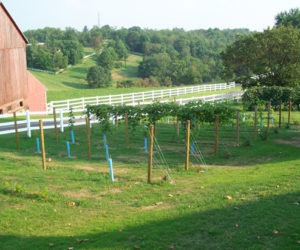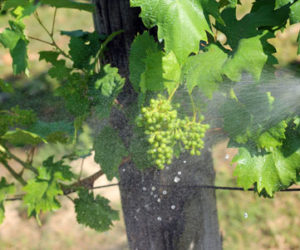 David Koball, Vineyard Manager at Bonterra Vineyards in Hopland, California. David has been growing winegrapes in Mendocino County in California for 14 years, all of it in certified Organic and Demeter certified Biodynamic vineyards. He has been working for Bonterra Vineyards for over seven years. Prior to growing winegrapes he was a Post Graduate Researcher at the University of California Davis in the Plant Pathology Department. He holds a Bachelor of Science degree in Plant Science from the University of California at Davis, and a Master of Science degree in Plant Pathology from Cornell University.
David Koball, Vineyard Manager at Bonterra Vineyards in Hopland, California. David has been growing winegrapes in Mendocino County in California for 14 years, all of it in certified Organic and Demeter certified Biodynamic vineyards. He has been working for Bonterra Vineyards for over seven years. Prior to growing winegrapes he was a Post Graduate Researcher at the University of California Davis in the Plant Pathology Department. He holds a Bachelor of Science degree in Plant Science from the University of California at Davis, and a Master of Science degree in Plant Pathology from Cornell University.
We grow organic and biodynamically certified winegrapes on 1,100 acres in Mendocino County in the North Coast region of California, over 13 miles from the northern to most southern, from flatlands by the Russian River to hillsides at 2,200 feet in elevation, so we have a lot of different challenges to our vineyards.
I suppose the organic challenge that gives me the most fits is spidermites. For late season infestations we do not have a good control material that completely fits our needs. Spidermites tend to be attracted to sunburned or stressed grapevines, and they enjoy a good hot day (100+ °F/38 °C), thus our challenge is to grow our vines in the most balanced way possible and ameliorate the stress of the very hot days. A balanced grapevine is one which is healthy, but not overly vigorous, and thus is not as attractive to the spidermites. We use irrigation, tillage, pruning, fruit thinning, and cover crops as tools to balance the vines. Cover crops are also great habitats that encourage the presence of natural predators such as the Minute Pirate Bug. We also purchase predatory spider mites from a company called Biotactics and inoculate our fields if they are not naturally present.
The first time that I relied solely on natural insect predators to control a spidermite outbreak, I was extremely nervous, but followed some of the protocols in the University of California Grape Pest Management book and it worked just as it was modeled. Once I saw that, I was hooked. How cool is it that you can sit back and let nature take care of it’s own problems without human intervention! I’m a “show me” type of person, so I had to see for myself that it really could work. The take home lesson was that this type of control strategy is viable; I now do whatever I can to encourage natural predators in the vineyard. I do this by planting cover crops and managing them to encourage habitat development. I like to keep vineyard borders messy so that they are also diverse, continual habitat not subject to my farming practices.
Insect pressure is a pretty universal challenge. We use Queen Anne’s lace and different clovers in our cover crop mix to help us attract beneficial insects. Having these particular covers helps us to establish naturally functioning micro-ecosystems within the larger agro-ecosystem to afford natural control of insect pests. Both of these covers set seed and dry out long before they become a problem for competition with the vines, and by allowing them to set seed we get a much better return germination the following year without tillage.
Organic grape growing involves choosing the right variety for the specific region and using the proper viticultural techniques and systems as well. In our part of Mendocino County, we can organically or biodynamically grow just about any variety imaginable, and do it successfully. Conversely, growing Chardonnay in a cool moist climate such as the Willamette Valley in Oregon or more coastal regions would be a much greater challenge. There are plenty of people growing organically in these regions, and they have my deepest respect and admiration for the success that they are having. I would think that mildew and rot pressures would be the greatest factor in choosing a winegrape variety to grow organically given a particular climate. Ripening is more a factor of choosing the right variety for viticultural reasons, not whether you are an organic or conventional grower.
A clean and tidy vineyard is not a sign of a good organic grower, it’s a sign of a clean and tidy grower. The more things that you have growing in your vineyard, the more real it becomes in terms of a naturally functioning ecosystem. Agriculture at its root is very unnatural; we need to do what we can to mimic what’s happening in natural systems if we hope to be successful. There can be too much of a good thing however, so an overly untidy vineyard is not so good either.
Always be ahead of what is happening, know what is coming instead of reacting to it after the fact. For organic growers, you need to make a lot of bootprints in the vineyard. For example, if you see a small hotspot of spidermites in a particular area of the vineyard, you need to look for predators immediately. If you establish a population of predators early, the hotspot may not develop into a problem. If you wait for the problem to develop and then treat, you will have a much greater degree of difficulty.
There are no herbicides available organically that we have heard of that have shown any great degree of success. Short of mechanical or manual (hand hoeing/shoveling) controls, a propane weed flamer is the best solution for weed control at the hobby level. Mechanical weeders for tractors are expensive and frequently break.
If you want to go organic, talk to as many people as you can, be they organic, biodynamic, sustainable or conventional growers. They all have personal experiences to share about what are typical problems wherever you are growing grapes. The best advice is from a fellow farmer because they have the same needs and perspective as you. Eventually you will develop a level of trust in a select group and you can all learn from each other.
 Dr. Robert Gross, owner and founder of Cooper Mountain Vineyards in Beaverton, Oregon. Cooper Mountain started as a few hand-planted vines in 1978. The winery received Oregon state organic certification in 1995. In 1999, the vineyards attained Biodynamic® certification and in 2002, Cooper Mountain became the first US winery to gain label approval for a no-sulfite-added wine under the National Organic Program standards.
Dr. Robert Gross, owner and founder of Cooper Mountain Vineyards in Beaverton, Oregon. Cooper Mountain started as a few hand-planted vines in 1978. The winery received Oregon state organic certification in 1995. In 1999, the vineyards attained Biodynamic® certification and in 2002, Cooper Mountain became the first US winery to gain label approval for a no-sulfite-added wine under the National Organic Program standards.
One big obstacle to growing organically at Cooper Mountain has been neighbors. We have an urban growth boundary on one side of our vineyards, which means a bunch of houses. When we started out, we were originally concerned about spraying our normal chemicals that we would use in grape production that would possibly affect their lawns and flowers. The problem, however, was just the opposite — it turned out that the homeowners were spraying their lawns and flowers with every commercial chemical known to man.
To solve the problem, we had to contact all the homeowners to explain the situation and make sure they understand that they are responsible if they damage our organic certification. Of course we had informed them ahead of time, but they hadn’t thought to inform other people who maintain their properties, like their lawn or gardening contractors.
As for challenges on a more universal scale, organic grape growing takes more labor. It is a special challenge. Here in Oregon we don’t have many natural pests, but weed control takes a lot of labor. We don’t necessarily do anything differently as far as planting certain varieties of grapes and we don’t choose anything special; we just find organic ways to work around any problems.
The other thing we do at Cooper Mountain Vineyards is that we are biodynamic, which is an extra step of spraying homeopathic substances on the plants and the soils to put them in balance, which was developed by Rudolf Steiner (visit www.biodynamics.com for more information about going Biodynamic). We’ve done blind tasting with experts and they have preferred the biodynamic as opposed to the plain organic.
The common sense tips for growing organically are to make sure that the ingredients that you spray with are certified organic (everybody has to spray). There’s a big long list of brands and things that you can use, which is available from your state’s certifiers, that says which particular chemicals are safe. The second is, like us, to protect your organic status from whoever is around you. Inform your neighbors and workers and you will be just fine.
I visited Argentina a year ago to a vineyard that was about 3,000 acres that’s all organic. I said to the owners, “my gosh, that’s huge,” but they said growing at that scale was not particularly different from us — it just involves a lot more labor. If you have a moderate climate, it’s not as difficult to grow organically. The climate and the natural predators here are not as great as in other parts of the country, so if you’re looking to grow organically in a more challenging region, you have to really know what you’re getting into based on your climate and soils.
For more information about organic standards in your state, contact your state board of agriculture or university extension. For information about national organic standards, visit the National Organic Program on the Web at www.ams.usda.gov/nop/indexNet.htm.

Lon Rombough, author of “The Grape Grower: A Guide to Organic Viticulture,” (Chelsea Green, 2002). Lon holds two degrees in horticulture and has completed Ph.D level work in plant breeding and genetics. He has more than 30 years of experience with hundreds of varieties and species of plants with organizations such as the National Clonal Germplasm Repository at Corvallis, Oregon and North American Fruit Explorers.
I have had the most luck with American and French hybrids — anything with American species in them are almost universally free of pests and diseases (other than fruit eaters such as birds) here because we don’t have strong disease pressure. The most serious problem is usually cracking and bunch rots in varieties that ripen late enough to get caught by fall rains on a regular basis.
The simplest thing for organic grape growing is putting your prejudices aside and choosing varieties for their ability to grow well for you, not because they are “classic” varieties. The old American grape Norton can be grown without disease in much of the US and as winemakers learn to use it, it makes outstanding red wines. Organic is eminently practical for ALL growers if the grower is willing to work with what will grow well first, then learn how best to use the grapes. I made wine from Schuyler that became my communion wine for my wedding. It convinced me that good wines didn’t have to be made just from vinifera.
My advice is don’t get in a sweat over small things. Be sure that something needs controlling before going nuts. If the rest of the area is in balance, there’s a chance there is a predator for the pest. For disease, start with resistant grapes.
There’s also nothing that says you can’t breed your own grapes if there are local species already adapted to your climate. There is a group of private and public grape breeders now active who are creating new types from native species that could easily be the next generation of really organic grapes.
If you’re going organic, don’t stop with one or two varieties. Do your homework and try a range of grapes. There are some excellent hybrids out there that make high quality wine, are wonderful table grapes and they have more hardiness and disease resistance than you imagine.






